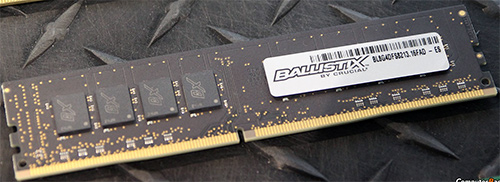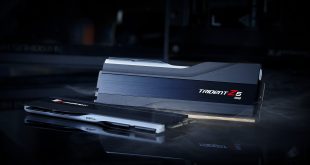Sometimes in the third quarter of this year Intel Corp. plans to release its next-generation high-end desktop (HEDT) platform code-named “Lituya Bay” based on the code-named “Haswell-E” central processing units that will rely on DDR4 memory to maximize bandwidth. For those, who will want to get some extra performance out of next-gen, makers of high-end memory modules will offer products with significantly enhanced performance.
Crucial, a division of Micron Technology (a major producer of dynamic random access memory [DRAM]), is developing new Ballistix DDR4 memory modules designed for performance enthusiasts and with up to 3.0MT/s (million transfers per second) transfer rates, reports ComputerBase. Given the fact that Intel’s new Haswell-E processor will officially support maximum DDR4 data-rate of 2133MT/s, the new Ballistix modules will provide rather sufficient headroom for performance improvements. The advanced Ballistix DDR4 devices will include new XMP profiles for DDR4 memory so that to make installation and usage of such products easier.
Intel’s “Haswell-E” central processing unit will be Intel’s first desktop processor to feature up to eight cores based on the Haswell micro-architecture. As a result, the chip will need higher memory bandwidth than today’s six-core Core i7 Extreme enthusiast-class microprocessors. With four DDR4 channels running at default 2133MT/s, the new Haswell-E will get 68.2GB/s of memory bandwidth (up from 59.7GB/s on Ivy Bridge-E-based systems). However, with 3MT/s memory modules, memory transfer rate will increase to 96GB/s.
Prototype of Crucial Ballistix DDR4 DIMM. Image by ComputerBase web-site.
At present, a number of DRAM module manufacturers offer enthusiast-class DDR3 memory solutions capable of running at effective 3GHz frequency or even higher. Such modules are designed to work in dual-channel configurations and usually cannot achieve their high data rates in quad-channel mode on HEDT platforms. The fact that Crucial decided to go with 3GHz DDR4 modules with the first-generation commercial DDR4 chips and the first-generation commercial DDR4 memory controllers implies that the technology has a good potential. Indeed, even conservative DDR4 standard points to 4.20MT/s maximum data rate for DDR4 standard.
Since Crucial Ballistix memory modules with 3.0MT/s transfer rate will be aimed at high-end desktops that use Intel Core i7 Extreme microprocessors, expect them to be priced accordingly.
Intel plans to release mainstream desktop and laptop platforms with DDR4 memory support only in late 2015, according to unofficial data. Those platforms will be powered by chips featuring the code-named Skylake micro-architecture. It is likely that by the end of 2015 manufacturers of DRAM introduce second-generation commercial DDR4 products with higher frequency potential.
KitGuru Says: Due to the fact that with consumer-class DDR4 platforms only one DIMM per channel will be supported, for many users it will make more sense to buy high-capacity DIMMs rather than fast DIMMs. Today, one can buy a DDR3 memory kit that delivers certain level of performance, then buy a similar one and add it into remaining slots on his/her mainboard. In case of a DDR4-based system upgrade, all DIMMs in a PC will have to be replaced with new ones.
 KitGuru KitGuru.net – Tech News | Hardware News | Hardware Reviews | IOS | Mobile | Gaming | Graphics Cards
KitGuru KitGuru.net – Tech News | Hardware News | Hardware Reviews | IOS | Mobile | Gaming | Graphics Cards




2 comments
Pingback: Nintendo's next move: consolidation - Page 2
Pingback: “Nintendo Fusion” Could Be Nintendo’s Next-Gen Hardware Name